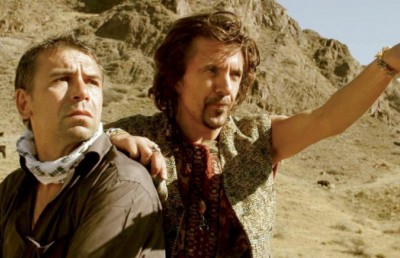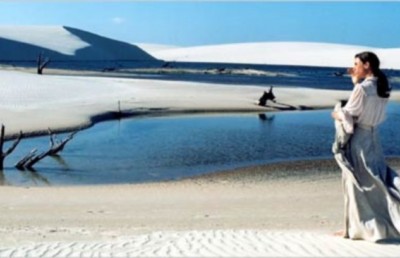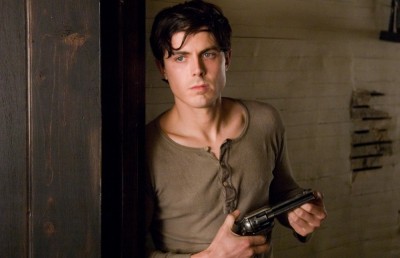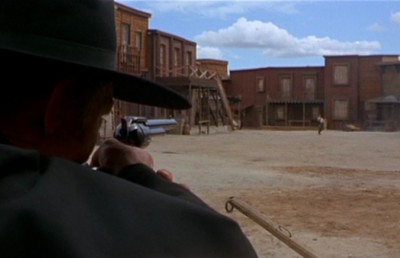The Good Son: John Hillcoat’s The Proposition
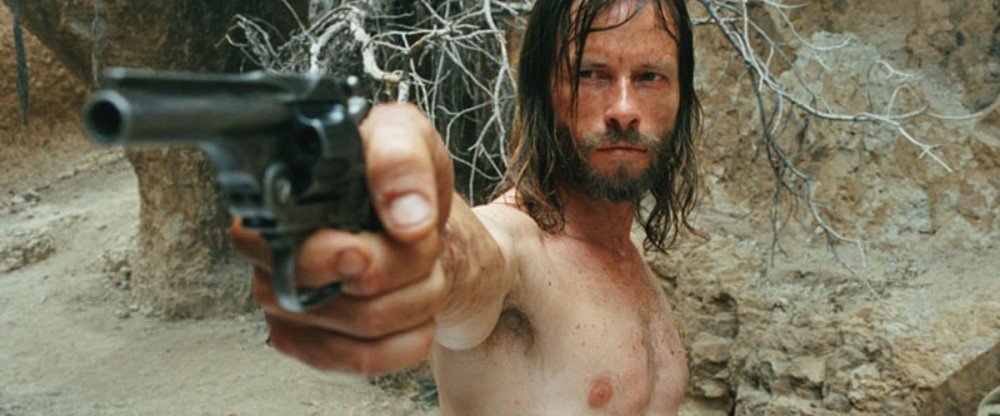
John Hillcoat’s The Proposition (2005) opens with a series of black and white photographs depicting the building of the British Empire in Australia. Some depict the settlers in single or group portraits; others portray the indigenous people, amongst images of hotels, clapboard shops and a school. Everything looks dirty and everything looks painful, harsh, real. The sequence then shifts from these general images to a more specific event: starting with a group portrait of the local police force, their rifles in hand and an uneasy gaze staring into the lens, the sequence proceeds with three related images. The first is of the remains of a burnt out house, a bare black and charred frame stark against the pale sands of the Outback. Following this is a photograph of three bodies, a man and a woman with a child laid out between them. The woman appears to have a deep cut on her forehead whilst the man has clearly been shot in the head. The child, their eyes closed, appears unharmed, resting peacefully in his premature death. An image of three crosses follows, each grave marker bleaches out into the morning sun. This image lingers on the screen to consolidate its value and importance, the serene non-diegetic music adding further melancholy to the evoked atmosphere.
An abrupt cut to the interior of a small, claustrophobic whore house.
Instead of fucking there is only killing: bullets pierce the corrugated iron with a sharp crack, glass shatters and objects explode. One man is shot in the throat, his blood spraying across the walls. Another shoots back through the shattered cabin window. A young man cowers at his feet, curling himself up into a tight ball as more bullets penetrate the small space. Another abrupt cut and the shoot out is over. The blood stained bodies of the dead are piled into a corner, one atop the other. At a bullet-splintered table sit two men, the one who was shooting and the man who cowered. They sit before a police man, recognisable from the photograph from the title sequence. He is Captain Morris Stanley (Ray Winstone), an Englishman, and the two men are Charlie (Guy Pearce) and Mike Burns (Richard Wilson), brothers of the infamous Arthur Burns (Danny Houston). They talk and Mike is pistol whipped for Charlie’s defiance. Comments are made about a recent rape and triple murder. From Stanley’s brief description it becomes apparent that the images that concluded the title sequence are the crime scene photographs from this incident, the so called Hopkins Outrage. Stanley is both disgusted and disturbed by this event, apportioning the blame to their absent brother and the rest of his gang. Stanley smiles and tells Mike that he will hang on Christmas Day if Charlie does not find, kill, and bring back the head of Arthur Burns within nine days.
So begins The Proposition.
Charlie Burns, the Good Son
Having accepted Stanley’s proposition, Charlie mounts his horse and begins his journey into the Outback. As he rides, he passes the remains of the Hopkins house. Tying up his horse, Charlie cautiously enters the house, pausing to take off his hat before crossing the burnt threshold. As he does so, Stanley is heard in voice over, his words seemingly echoing in both Charlie’s mind and through the hollow remains of the house: “Arthur Burns is a monster. An abomination. What happened at the Hopkins place was unforgivable. I have never seen such a sickening sight. Did you know poor Eliza Hopkins had a child in her belly?”
Up to this point, Hillcoat has saturated the narrative’s imagery with immensely vivid colours – burning oranges, shimmering yellows and bright, bleaching sunlight, all indicative of the searing heat and arid landscape of the Outback– but as Charlie walks through the house these vibrant colours have drained away, leaving only cold, charred browns, mottled and peeling blue tints amongst the scorched black walls. Life has literally been drained away from this house, leaving only the wreckage of what was a family home, smashed, ripped and singed photographs amongst the ash and spent cartridges. Charlie continues to walk through the house, unsteadily making his way down a corridor towards a door. He reaches out and slowly opens it, revealing a child’s room. The walls are charred but the crib that stands at it centre remains untouched, its white cloth and lace trimmings dazzling in the sunlight.
The Hopkins house and its crib are obvious symbols, particularly in relation to the Western genre’s lexicon of imagery: within the traditional Western a house, even if it is nothing more than a bare timber frame standing on the edge of the wilderness, is symbolic of the civilising forces within the narrative. The home brings a rigid geometric order to the chaos of nature and provides a clear boundary between the civilised and the uncivilised, between the private and the public. In Hillcoat’s film this symbolic has been inverted for the house has been raised –instead of fresh timbers signifying a new era of civilisation there is only the charred uprights, pitch black against the pale blue sky. Here, in the Outback and within in the construct of The Proposition, civilisation has failed for chaos has consumed it with “unforgivable” violence. This brutality is made all the more grotesque (and possibly all the more poignant) through Charlie’s discovery of the crib. In relation to the narrative, this crib is a physical manifestation of Eliza Hopkins’s unborn child whereas in relation to the inversion of generic tropes, the crib does not represent the literal birth of this new civilising generation but the death of it, a further signifier to the failure of the attempts to civilise this arid land.
It is not clear as to whether Charlie and Mike actually participated in the Hopkins Outrage. This implication suggests that Charlie is consumed by guilt over past crimes and for his inability to stop his brother committing further crimes. In this morally ambiguous position, Charlie accepts ‘the proposition’ for it would seem, as the subsequent narrative implies, that he has already considered killing his older brother prior to the start of the film but has been unable to reconcile this fratricide with himself. This is made all the more evident and reinforced by Arthur himself who repeatedly asks Charlie “When are you going to stop me?” In this respect, Stanley’s proposition provides Charlie with a legitimate rationale for the murder: by taking the life of the older bad brother he can both save the younger good brother and absolve himself from past crimes. Such qualities place Charlie as a morally ambiguous protagonist to such an extent that he almost fulfills the archetypal representation of the revisionist Western hero: neither good nor bad but imbued with a strong sense of moral code, he searches both the wilderness and himself for redemption in the most violent of acts. As Hillcoat has commented, Charlie “displays the generic traits of the Western character. He is a man of the land, he rides into the desert on his horse with nothing behind him and only peril in front of him.” (Kissoon)
Such qualities align Charlie with two recent revisionist Western heroes, William Munny (Unforgiven [Clint Eastwood, 1992]) and Charley Waite (Open Range [Kevin Costner, 2004]). Of these two Western heroes, Charlie can be paralleled the most with Munny: in self exile, the notorious killer Munny struggles with both life as a Frontier farmer and with the guilt of his murderous past. Although claiming to be reformed, Munny is drawn back into bounty hunting through personal circumstance, a situation which allows him to finally comfort and ultimately accept who and what he is. Munny’s narrative trajectory suggests that redemption may not be possible but a sense of it may be achieved in the rectification of current wrongs. As Munny often mumbles throughout the film “they had it coming.” Munny’s revisionist qualities are deftly defined by writer David Webb Peoples and Eastwood’s measured performance and direction. Such is the extent of this, that Munny’s restrained dialogue and controlled actions render the film more as a character study –a long and blatant exposition of one man’s violent past and its consequence upon his present.
??The Proposition??’s writer Nick Cave and director Hillcoat take this singular quality and amplify it to an immensely medative state that Charlie is not just paralleled with Munny but it is effectively positioned as his equal: both are struggling for redemption whilst both unconsciously accept that this is probably not possible. Both reflect upon the murder act and attempt to rationalise it (or to at least displace it or distance it from themselves). But for all these essential parallels, there remains one significant difference between these two men: their use of the gun.
The gun is one of the most powerful symbols in the Western. As a weapon it extends the body of its user and literally places life and death in their hands. To use it with accuracy assures a mythical status as much as it induces fear. As a symbol, it is a blatant manifestation of dominate male power, authority and control. For Munny the gun is a tool of his previous trade, a necessity in order to get the job done where as for Charlie the gun is merely there for protection. Throughout the duration of The Proposition, Charlie is seen to fire his gun on three occasions: the first is in self defence during the whore house siege; the second is the mercy killing of Jellon Lamb and the third when he executes gang member Samuel Stoat (Tom Budge) and murders his brother. Hillcoat comments upon this relationship as one that is potentially at odds with Charlie’s criminal status:
The gun in The Proposition is taken up by Charlie as a necessity. Unlike [Stanley’s] law officers who drunkenly handle and go over the gun, Charlie is painted to want peace – both for himself and Mike. Where the officers seemingly shoot wontedly and use the gun as a symbol of status, Charlie only shoots in self-protection at the beginning and at the close of the film to end the violence. His brandishing of his gun is at odds with his seeming desire for a peaceful life. (Kissoon)
In his article Forgiven, Jim Kitses suggests that characters such as Munny and Waite (and by implication Charlie) are ‘anachronistic warriors’ who coherently function as a natural culmination of ‘the darkening image of [the Western’s] violent protagonists,’ all of whom conclude their narratives as ‘the hero as executioner.’ He also suggests that ‘the demands of justice typically sanction their violence [but] taking life nevertheless can render them persona non grata.’ This seems a high price to pay but both Munny and Waite are fighting to save one of the most deeply engrained values of the Western, the family: Munny decides to pursue a bounty for he fears his children will die of starvation otherwise, whilst Waite avenges a death within his surrogate family. By the end of both narratives, the family unit that has been held so sacred has been successfully restored to its harmonious state. Lives have been lost and that is the cost of familial unification but they will not be forgotten for lives have also been saved and brought back together. It would seem then, that in these revisionist times, that regardless of the violence the heroic executioner must endure, all is redeemed by their ability to draw their family back together. But, for Charlie Burns, no such ending awaits. His narrative has begun with familial fragmentation and, as such, can only end in further fragmentation.
For all of Charlie’s heroic status it is possible to argue that it is his brother Arthur who burns at the centre of The Proposition. His first appearance in the film is brief: as Stanley defines his proposition to Charlie, Hillcoat cuts from the whore house to a static image of Arthur standing in silhouette against a dramatic sunset. He is a black shape, his form slightly shifting as a gentle breeze catches his dust coat. The sky is streaked with burning oranges and a pale purple, bruised and battered, smeared with the grey smudges of clouds and so aligning Arthur with the sublime qualities of the wilderness and so implies his mythic potential. This quality is later amplified when Charlie meets Jellon Lamb for the first time. Lamb indicates his trade as a bounty hunter and then offers a poetic commentary on Arthur when he says:
He sits up there in those melancholy hills. Some say he sleeps in caves like a beast. Slumbers deep like the kraken. The Blacks say that he’s a spirit. The troopers will never catch him. Common force is meaningless as he squats up there on his impregnable perch.
Lamb’s suggestion that the Aboriginals believe Arthur to be a spirit is confirmed when Stanley questions a group of captured Aboriginal elders. The elders suggest that Arthur transforms into a dog-like beast at night, growing ears and a tail, who then stands amongst the hills and howls. Both Lamb’s description and the Aboriginals belief consolidate that first opening image of Arthur for they all align him with the landscape: in their minds he is some sort of half-man, a beast, a creature whose powers are as mythic as the landscape itself.
Hillcoat forces this parallel throughout the remainder of the film for he continually cuts to static images of Arthur’s silhouette brooding before a sunset or sunrise. In each image this brother looks out into the vast landscape and although his deep black form dominates the frame, his shape is dwarfed by the Outback. It is almost as though the landscape has absorbed him or he has become part of it. His gaze, of looking out into the chaotic wilderness, only furthers Arthur’s mythic values: is he looking into a heart of darkness, into a reflection of himself or is he simply standing guard as he surveys the horizon for the return of his brothers?
One of the film’s most tender and most tragic moments takes place during an extension of this image: having finally found Arthur, the brothers sit together and look out into the landscape. They sit in silence for a while before Arthur asks about Mike. Instead of telling the truth, Charlie lies and tells him he has found a girl, Molly O’Boyle, a girl whose hair is as red as the sunset. Nick Roddick suggests that this short scene is probably one of the best in the film
…not just for its pictorial beauty but for its brilliant marshalling of irony. We know Charlie is lying: Mike is locked up and probably dying in Stanley’s jail. But the details he invents for Mike’s girl under Arthur’s cheerful but relentless questioning –her name, family background, cooking skills– represent a yearning that both brothers find hard to resist. Best of all, there is every possibility that Arthur knows Charlie is lying, that he sniffs the possibility of a set-up, thus preparing us for the film’s wonderful ending.
The Proposition concludes on Christmas Day. As Stanley and his wife, Martha (Emily Watson), sit down for their dinner, Arthur and Stoat assault the house. Morris is taken into his study by Arthur who proceeds to beat him senseless whilst Stoat sits and eats with Martha. After a long wait, Arthur calls them into the study where Stanley, wrapped in a bloody Union Jack, is forced to watch Tom rape his wife. As Tom undoes his belt, Charlie walks calmly into the house and shoots Stoat in the head. Turning to Arthur, he shoots him once in the stomach and then once in the chest. As Arthur staggers out of the house, Charlie looks from Martha to Stanley. Instead of killing them Charlie simply says “I’m going out to be with me brother.”
This attack on the Stanley household brings a sense of circularity to the narrative. It began with members of the Burns Gang assaulting one family’s home and now ends with a similar event. Such is the extent of this parallel it can be suggested that the attacks upon Morris and Martha effectively show the audience, in graphic detail, the attacks upon Eliza Hopkins and her husband. These are violent moments in which the narrative’s recent history plays itself out again and vengeance, that other classic Western trope, is given full vent. Arthur punishes Stanley for the numerous crimes he has committed against him (the establishment of the proposition, the turning of brother against brother, and Mike’s death) yet this punishment also functions as a confessional act, another reason, if another were needed, for Charlie to “stop him.” Arthur now knows that Charlie is no longer one of them, no longer an outlaw and no longer family. For Arthur, Charlie now exists outside of those structures and instead occupies an uneasy ground where he is neither good nor bad, friend nor foe.
For all the violence, blood and death of the final scenes, it is worth emphasising that Charlie does not murder the Stanleys. Charlie began his redemptive search for Arthur by entering into the scene of the Burns Gang’s last crime. The burnt out wreckage of the Hopkins home now resonates even further as Charlie leaves these civilised people unharmed, alive and well within the rigid geometry of the domestic home and ready to continue the civilising act. He is not one of them, yet when Stanley delivered his proposition at the start of the film, he turned to Charlie and said “Make no mistake Mr Burns, I will civilise this place.” But, by the narratives end, it is Charlie the outlaw and not Stanley the lawman who has civilised “this place.” While Morris may be a lawman and with his wife have a symbolic house, The Proposition concludes by suggesting that it is not domesticity that civilises the wilderness and those who inhabit it but violence. It is the only language the chaotic and unlawful understand. Even so, the film concludes in a typically generic manner for law and order has been restored by the tragic hero instead of the lawman, restored by the man who shot and killed his brother.
References
Kisson, Hemanth, “When Hemanth met Hillcoat,” Close-up Film. Accessed 01/02/08.
Kitses, Jim, “Forgiven,” Sight and Sound, April 2004.
Roddick, Nick, “Ballad of the Wild Boys,” Sight and Sound, March 2005


